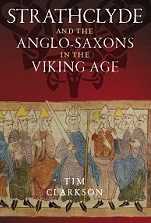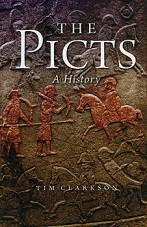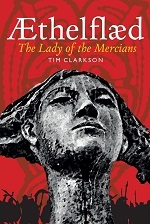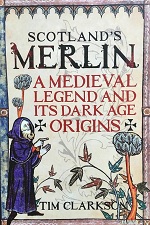
The collection of carved stones at Govan Old Parish Church is one of the great treasures of Dark Age Celtic sculpture in Britain. With an impressive thirty-one monuments, the Govan collection is the third largest in Scotland. Sadly, this figure represents only two-thirds of the total seen by visitors 100 years ago. At that time, the stones were still outside, in the churchyard, mostly dotted around among later memorials. Only the Sarcophagus and three others had any kind of protection, being housed in a small outhouse in the south-east corner of the churchyard. The total number of stones was forty-six, of which sixteen have since been lost. The missing ones were all of the same type: the recumbent cross-slab, designed to be placed lengthways on top of a grave. They all had a large cross carved on the front, surrounded by Celtic interlace in the ‘chunky’ style favoured by the Govan stonecarvers. By the end of the nineteenth century, after a thousand years of exposure to the elements, many of the ancient carvings had worn away.
One of the lost slabs is shown in the illustration above, reproduced from Sir John Stirling-Maxwell’s Sculptured Stones in the Kirkyard of Govan, a photographic record published in 1899. Sir John numbered all the ancient stones in sequence, designating this slab as ‘Number 29’. Although he didn’t provide a written description, he gave us our only pictorial record of this unique monument. His privately published volume is, in fact, a definitive catalogue of all forty-six stones (plus the shaft of the ‘Govan Cross’ which had been moved to the garden of Jordanhill House in Partick). In 1903, a description of Number 29 appeared in Allen and Anderson’s magisterial survey of Dark Age sculpture, The Early Christian Monuments of Scotland (usually abbreviated as ECMS). Sir John’s numbering system wasn’t followed by Allen and Anderson, who instead catalogued the slab as ‘Number 18’ in their own listing of the Govan collection. Here’s how they described its carvings:
‘The cross, devoid of ornament, and the top arm defaced by the modern initials W.I. On the background (to the left and right of the top arm, and above it) traces of interlaced-work; (to the left and right of the shaft) traces of interlaced-work; and (below the bottom of the shaft) sculpture defaced.’
The initials were probably applied in the seventeenth or eighteenth century and show that this slab was re-used at least once after the medieval period. Many of the ancient stones at Govan were recycled in this way, sometimes with the year of re-use as well as the initials of the deceased. The identity of ‘W.I.’ is unknown but he or she would have belonged to a prominent family in pre-industrial Govan.
Sir John Stirling-Maxwell published a plan of the churchyard (see below) showing the positions of all the stones at a date roughly in the mid-1890s. This enables us to imagine where cross-slab 29 lay in relation to other Dark Age monuments before the beginning of the twentieth century, by which time many of the slabs had been laid in a line along the churchyard’s eastern wall. It is unlikely that Sir John’s plan shows Number 29’s original position in early medieval times: old records of the parish indicate that ancient stones were often moved to suit the pattern of newer burials.

Archaeologists date the carvings on the Govan cross-slabs to the period 900 to 1100 AD. The absence of secular motifs such as warriors and animals suggests that these were gravestones for the clergy – members of the local religious community – when Govan was a centre of royal power in the kingdom of Strathclyde, but it is also possible that they commemorated the warrior aristocracy as well. The names of the deceased are unknown, for no early inscriptions are visible on any of the Govan stones.
What happened to Number 29 and why is it missing? The answer to these questions brings us to one of the most tragic chapters in the long history of the Govan Stones.
In 1908, the Sarcophagus was removed from the outhouse in the south-east corner of the churchyard and brought inside the church, where it has remained ever since. The outhouse was becoming damp and dilapidated, and there was much concern about the condition of the other three stones left behind. Someone suggested moving all forty-six ancient stones inside the church for safekeeping but, unfortunately, this did not happen. Many of the cross-slabs and three of the five hogbacks still lay next to the churchyard’s eastern wall, exposed to the elements. Eventually, in 1926, the best-preserved stones – the hogbacks, the Sun Stone and the Cuddy Stane – joined the Sarcophagus inside the church. Two years later, the shaft of the Govan Cross was returned from Jordanhill House and also placed inside the church. Today it is sometimes known as ‘The Jordanhill Cross’ in memory of its period of exile on the other side of the Clyde. More stones were subsequently brought in from the churchyard, taking the total inside the church to twenty-six. The only ones still left outside were a cross-slab near the west door and another twenty slabs along the eastern perimeter wall.

Hogbacks and cross-slabs against the east wall, c.1900.
In 1973, a huge factory building in the disused Harland and Wolff shipyard was demolished. Part of this structure stood near the east wall of the churchyard and, during the demolition process, a large amount of debris tumbled over the wall. The twenty ancient slabs lying on the grass were damaged, many of them severely, and only four survived. ‘Number 29’ was among the casualties. With its fellow-victims it is now little more than a ghostly photographic image in the pages of Sir John Stirling-Maxwell’s book.
* * * * *
Notes
Much of the information in this blogpost comes from ‘The Govan collection in the context of local history’, a chapter by Tom Davidson-Kelly in Govan and its Early Medieval Sculpture, edited by Anna Ritchie (1994). Reverend Davidson-Kelly was formerly the minister of Govan Old and a key figure in the preservation and conservation of the ancient stones.
The initials W.I. carved on ‘Number 29’ can also be seen on one of the surviving cross-slabs (Stirling-Maxwell’s ‘Number 27’) with the date 1634. Maybe these two stones were re-used by the same family, to commemorate namesakes from different generations?
The photographs in the Stirling-Maxwell book don’t show the actual stones themselves but copies cast in plaster by a certain ‘Mr J.W. Small of Stirling’.
In this blogpost, I have referred to the lost cross-slab using the Stirling-Maxwell designation ’29’ rather than the ’18’ of ECMS. This is mainly to reflect the fact that Sir John has left us the only visual image of this vanished relic from the Dark Age kingdom of Strathclyde.
* * * * * * *







